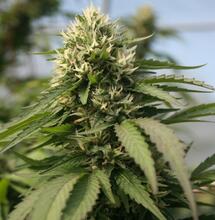Who First Used Cannabis?

A research team led by archaeologists at the Chinese Academy of Sciences in Beijing found evidence that mourners burned cannabis for its psychoactive fumes on a remote mountain plateau in Central Asia around 2500 years ago.
The study, published today in Science Advances, leans on new techniques that allow researchers to determine the chemical signature of the plant and evaluate its potency. The study is part of a broader effort to chase how cannabis spread along the budding Silk Road on its fledgling steps to becoming the globally used "drug" it is today.
Cannabis is thought to have first grown around 28 million years ago, high on the eastern Tibetan Plateau. Over 4000 years ago, Chinese farmers began producing oil and fibre to make rope, clothing, and paper. Cannabis still grows wild across Central Asia.
Identifying when people began to take advantage of the psychoactive properties of cannabis or hemp has proved tricky. Archaeologists have made assertions of ritual cannabis burning in Central Asia as far back as 5000 years ago. However, new studies of plant remains suggest that early cannabis strains had deficient levels of THC and lacked mind-altering properties.
The cannabis burned 2500 years ago in the Pamir Mountains of far western China was different.
Excavations uncovered skeletons, wooden plates, bowls and other vessels that had once held the burning material. This is typical of the Sogdians, a people of western China and Tajikistan who typically followed the Persian faith of Zoroastrianism. This belief celebrated the psychoactive properties of cannabis in their religious texts. Glass beads from Western Asia and silk from China ensured the long-distance trade for which the Sogdian people became renowned.
The analysis of 34 skeletons showed that nearly a third were migrants. Radiocarbon analysis placed the burials at around 500 B.C.E.The research team ground parts of the wood vessels discovered into powder, applying gas chromatography and mass spectrometry to identify the chemical compounds left behind. Unusually high levels of THC were found compared with regular wild cannabis.
The wooden vessels were generally found in the tombs of people with a higher social stature. The cannabis would be burned in an enclosed space to allow mourners to inhale, making this the earliest tangible evidence of cannabis being used for psychoactive purposes.
It is possible that the territory's high altitude could have affected the cannabis, creating strains naturally higher in THC.There are also theories that the fragrant fumes may have played a part in masking the smell of a putrefying corpse.
Researchers think that cannabis use was limited to the nobility class until it inevitably began to spread across Central Asia via the Silk Road linking China with Iran.
Ancient artwork and text from Syria to China hint at possible even earlier cannabis drug use. New analytical methods may soon provide concrete evidence of this. However, it's already clear that the ancient Silk Road trafficked more than spices, grains, and ideas.





